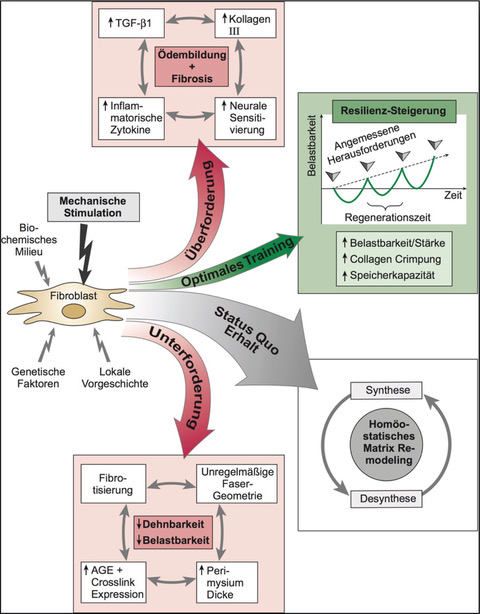Davis Law
The Davis'sche Act (Engl. Davis' law ) is a term used in anatomy and physiology . It explains how connective tissue adapts to mechanical loads. Davis' law is an extension or specialization of Wolff's law , which originally only referred to bone structure.
Davis' law can also be seen as a concrete application of Harold Frost's mechanostat model , which was primarily developed to describe the adaptability of bones. In later publications by Frost, however, he also applied the Mechanostat Model to fibrillar collagen tissues such as ligaments, tendons and fasciae . The model's stretch-hypertrophy rule states:
- "Constantly repeated stretches cause hypertrophy of the loaded collagenous tissue until the increase in strength achieved reduces the extent of its flexibility to stretch in at least a minimal way."
Similar to bone tissue, however, this adaptation reaction only occurs when the mechanical load exceeds a certain threshold value. Harold Frost suggested that this threshold value should be 23 N / mm² or 4% elongation in the case of coarse collagen-containing connective tissue. In the area of sport, especially in fascia training, reference is made to Davis' law.
origin
Davis's Law refers to Henry Gassett Davis , an American orthopedic surgeon (born 1807 in Maine, died 1896 in Massachusetts), who described the law he postulated in his book " Conservative Surgery " as follows:
- »Ligaments as well as all other soft tissues will elongate through additional material accumulation, provided they are exposed to constant tensile loads of at least moderate strength. Conversely, if these tissues are in a shortened or loose position for long periods of time without interruption, they will gradually shorten. The latter happens by breaking down so much excess material that they have restored the same relationship to the bony structures as they were before they were shortened. Nature never wastes time or material on maintaining the original length of a muscle or ligament if the distance between its origin and insertion is constantly shortened for a long time. "
Davis also used this law to explain scoliosis . This contradicted the statements of other experts of his time. In Conservative Surgery, Davis contradicts the statements published by Louis Bauer of the Brooklyn Medical and Surgical Institute that "the shortening of ligaments would be a physiological impossibility".
Individual evidence
- ^ Todd Ellenbecker: Effective Functional Progessions in Sport Rehabilitation. Human Kinetics, 2009, ISBN 0-7360-6381-1 .
- ↑ HM Frost: Defining osteopenias and osteoporoses: Another view (with insights from a new paradigm) . In: Bone . tape 20 , no. 5 , May 1997, pp. 385-391 , doi : 10.1016 / S8756-3282 (97) 00019-7 , PMID 9145234 .
- ^ HM Frost: The Utah Paradigm of Skeletal Physiology. Vol. 1, ISMNI, 1960.
- ↑ HM Frost: New targets for fascial, ligament and tendon research: a perspective from the Utah paradigm of skeletal physiology. In: Journal of musculoskeletal & neuronal interactions . tape 3 , no. 3 , September 2003, p. 201-209 , PMID 15758342 .
- ↑ a b Harold Frost: The physiology of cartilagenous, fibrous, and bony tissue. CC Thomas, 1972.
- ↑ HM Frost: Does the anterior cruciate have a modeling threshold? A case for the affirmative . In: Journal of Musculoskeletal & Neuronal Interactions . tape 2 , no. 2 , December 2001, p. 131-136 , PMID 15758460 .
- ↑ G. Orlando: Regenerative Medicine Applications in Organ Transplantation. Academic Press, 2013, p. 180.
- ^ HG Davis: Conservative Surgery. Appleton & Co., New York 1867.
- ^ Louis Bauer: Lectures on Orhopedic Surgery: Delivered at the Brooklyn Medical and Surgical Institute. Wood, 1868.